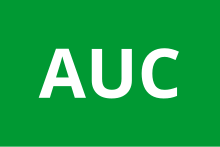


The United Self-Defenders of Colombia (Autodefensas Unidas de Colombia, or AUC, in Spanish) were a Colombian far-right paramilitary and drug trafficking group which was an active belligerent in the Colombian armed conflict during the period from 1997 to 2006. The AUC was responsible for retaliations against the FARC and ELN communist organization as well as numerous attacks against civilians beginning in 1997 with the Mapiripán massacre.[1]
The militia had its roots in the 1980s when militias were established by drug lords to combat rebel kidnappings and extortion by communist guerrillas.[2] In April 1997 the AUC was formed through a merger, orchestrated by the ACCU, of local right-wing militias,[1] each intending to protect different local economic, social and political interests by fighting left-wing insurgents in their areas.[3]
The organization was believed to have links to some local military commanders in the Colombian Armed Forces.[1][4] According to Human Rights Watch, the paramilitary groups and the armed forces of Colombia share a very close connection and due to which paramilitary groups are also perceived as an extension, more commonly called sixth-division, of the Colombia's armed forces which has five official divisions.[5][6]
The AUC had about 20,000 members and was heavily financed through the drug trade[3] and through support from local landowners, cattle ranchers, mining or petroleum companies, and other companies such as Chiquita Brands International, and politicians.[7]
The Colombian military has been accused of delegating to AUC paramilitaries the task of murdering peasants and labor union leaders, amongst others suspected of supporting the rebel movements[7] and the AUC publicly and explicitly singled out 'political and trade union operatives of the extreme left' as legitimate targets.[1] Powerful links to the Colombian government were never proved. The AUC was designated as a terrorist organization by many countries and organizations, including the United States, Canada and the European Union.[8]
The bulk of the AUC's blocs demobilized by early 2006 and its former top leadership was extradited to the U.S. in 2008. However, local successors such as the Black Eagles continue to exist and death threats have been made using its name. On May 8, 2008, employees of a community radio station (Sarare FM Stereo) received a message stating: "For the wellbeing of you and your loved ones, do not meddle in subjects that do not concern the radio station. AUC, Arauca". A few days later the letters AUC were daubed on the front of their office. This threat was made due to their participation in a public meeting attended by members of a Congressional Human Rights Commission on the 27 September 2007. Here, members of the public denounced human rights abuses committed in Arauca Department by different parties to the armed conflict, including the AUC.[9]
- ^ a b c d e Uppsala Conflict Data Program Conflict Encyclopedia, Colombia, One-Sided violence, AUC-Civilians, 1997–2005, http://www.ucdp.uu.se/gpdatabase/gpcountry.php?id=35®ionSelect=5-Southern_Americas# Archived 2013-06-06 at the Wayback Machine
- ^ BBC, Quick Guide, The Colombian conflict Archived 2013-11-10 at the Wayback Machine.
- ^ a b The National Consortium for the Study of Terrorism and Responses to Terrorism, Terrorist Organization Profile:United Self-Defense Forces of Colombia (AUC), http://www.start.umd.edu/start/data_collections/tops/terrorist_organization_profile.asp?id=126 Archived 2013-07-27 at the Wayback Machine
- ^ "Archived copy". CBS News. Archived from the original on 2012-11-04. Retrieved 2020-04-16.
{{cite web}}: CS1 maint: archived copy as title (link) CS1 maint: bot: original URL status unknown (link) - ^ Joanne Mariner; Malcolm Smart (2001). "1 I. SUMMARY AND RECOMMENDATIONS" (PDF). The "Sixth Division" : military-paramilitary ties and U.S. policy in Colombia (illustrated ed.). New York, NY: Human Rights Watch. p. 1. ISBN 9781564322654. Archived (PDF) from the original on 2016-12-13. Retrieved 30 April 2017.
- ^ Chomsky, Noam. "On Colombia". chomsky.info. Archived from the original on 2017-05-18. Retrieved 30 April 2017.
- ^ a b Rivera, Edgar de Jesús Velásquez (2007). "Historia del paramilitarismo en Colombia". História (São Paulo) (in Spanish). 26 (1): 134–153. doi:10.1590/S0101-90742007000100012. ISSN 0101-9074.
- ^ "Chapter 6 – Terrorist Organizations". 30 April 2007. Retrieved 2017-06-25.
- ^ "Colombia: 'Leave us in peace!' : Targeting civilians in Colombia's internal armed conflict". Archived from the original on 2013-12-30. Retrieved 2016-12-04.
